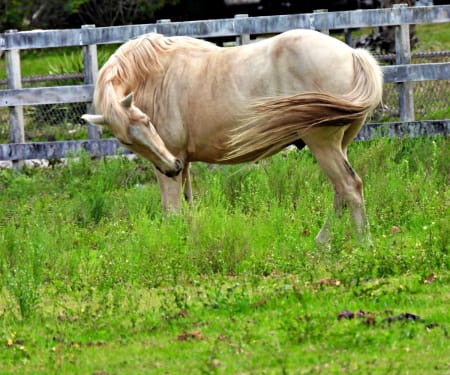Mite infestations on a horse's skin or in a horse's environment are a pain to deal with, but can also jeopardize the health and happiness of your horse.
So what should you do if your horses face this microscopic threat? How can you kill these pests without harming your horses? Let's talk about treating feather mites without threatening your horse with harsh chemicals.
Feather Mites 101
Feather mites (a.k.a. chorioptic mites) are the most common type of mites in horses. A feather mite likes to feed on skin debris, and if there's enough food, adult mites can survive on a host for almost 70 days. Mites live in horses' hair and the crusts on their legs.
Mites' presence on horses leads to discomfort, itching and possibly even health complications. If left untreated, a feather mite infestation can lead to open sores, hair loss and damaged feathers. These issues, if prolonged, can threaten your horse's wellbeing.
Mange

One elevated issue feather mites can cause on horses is chorioptic mange, which is essentially a hyper-irritated skin condition caused by feather mites. Chorioptic mange causes horses' skin to be dry, which leads to dandruff. This allows for harmful fungi and bacteria to thrive, which can lead to mud fever.
Feathered horses have characteristically long hair on their lower legs, which makes a perfect home for these particular mites. This is why chorioptic mange is sometimes referred to as leg mange. Other types of mange include mane mange, demodectic mange, psoroptic mange and sarcoptic mange, the latter of which is the most severe and most rare.
How to Know if Your Horses have Feather Mites
A mite infestation on your horses can typically be identified by lots of scratching and instances of irritated skin. If there's a really bad infestation, horses will even stamp their hooves due to discomfort. Lower limbs affected by mange can develop scaling and skin thickening, which could even get infected if left untreated. And to make it worse, some horses are allergic to mite saliva and have an allergic reaction that comes with intense itching, called sweet itch.
If your horses are itching and expressing discomfort but you're not certain that it's because of mites, you can ask your vet to do a clinical test called a skin scraping. Your vet will shave the feather to get some dead skin cells from your horse, then look at the cells under a microscope to determine if there are clinical signs of a mite infestation.
Usually, a skin scraping is not necessary to tell if your horse has mites. However, it can help tell you for certain the species of mites your horse is infected by and if there are any specific steps you need to take to fight them. If your horse is itching and has irritated skin, you can generally come to the conclusion that they are battling with mites.
How to Treat Feather Mites
There are a few options for treating chorioptic mites, including injectable wormers, topical treatments, nutritional supplements and, our favorite, all-natural mite spray Desecticide.
Injectable Wormer

If you consult your vet about mites, they can give you an injectable wormer that can be administered into the muscle tissue over the course of a few weeks. This method can be expensive and is usually accompanied by the next method, topical treatments.
Topical Treatments
A topical treatment can also be used to combat a mite infestation. Topicals can include Fipronyl spray, Pyrthroids and sulphide selenium wash. These treatments are effective for killing live mites, but they typically do not kill mite eggs. This means eggs continue to hatch and susceptible horses can become easily re-infected. Treatments must continue to be administered to address each new generation of mites, which can become costly in time and money.
Nutritional Supplements
Making sure your horses are in tip-top shape nutritionally is a good way to help them fight mites. You can boost a horse's immune system with echinacea, Vitamin C, grape seed oil and aronia berries. But while nutritional supplements like these make your horses better equipped to fight the symptoms of a mite infestation, they do not actually kill mites.
Natural Mite Spray: Desecticide

To us, the best way to eliminate mites on horses is Desecticide. Though originally designed as a treatment for mites and darkling beetles on chickens, Desecticide has proven to be an effective treatment for mites on horses and other livestock as well.
Desecticide is a non-toxic insecticide based on essential oils and surfactants. It's safe to spray in horse stables and directly on horses. It kills insects on contact by suffocating live mites and their eggs.
Pests cannot build resistance to Desecticide, so you don't have to worry about rotating products. There is no re-entry wait time or re-application limit, and it is safe for the environment.
-
Safely kills soft-bodied insects, like feather mites, harvest mites and straw itch mites
-
Can be used in horse facilities and directly on horses and other animals
-
Pests will not build resistance
-
No application license or veterinary assistance required
Eradicate Mites Without Harming your Horses
Desecticide is a highly effective pest killer that is completely non-toxic for horses, humans and pets. But it sure is toxic for mites! Desecticide targets neurological receptors active only in insects and arthropods to kill mites and other insects. Mites are a huge pain with horses, but with Desecticide you’re also covered for flies, beetles, mealworms, bed bugs, fleas and ticks.
On the packaging, you’ll see that Desecticide is a “chicken mite concentrate treatment.” We originally made this product for poultry, where chicken mites are the main pest issue. Because of this, we typically market this product towards chicken raisers.
Desecticide is just as effective on mite populations that impact horses. While homemade remedies can help out, they really can’t eliminate a mite infestation like Desecticide can. And while traditional pesticides can be effective, they can be expensive and expose you and your horses to harsh chemicals.
One of the best benefits of Desecticide is that you can spray it in your stable and directly on horses. No need to worry about taking them out and making them wait before returning to their home! Your equine friends will be completely unbothered by this pest control spray.
Desecticide is effective in 24 hours, so you can get rid of your infestation quickly. Bugs can’t build resistance to Desecticide, and there is no-reapplication limit. So you can use Desecticide until your mite problem has been solved. Plus, Desecticide is safe for the environment, so no need to worry about your garden, pasture or lawn being hurt by it.
How to Apply Desecticide
Desecticide can be applied easily by you—no professional services needed! To get rid of mites and more, simply apply 6 ounces of Desecticide per ½ gallon of water and apply with a sprayer around the stable. This should cover 250 sq. ft. You can use this same dilution to mist your horses where the mites are.
The next instruction is especially important. When mixing, start with the water first, and then add in Desecticide. If you add the water to the Desecticide instead, you will get a foam.
Itch-Free, Happy, Healthy Horses

We hope you never have to deal with mites on your horses. But if you do, consider Desecticide as a means to eliminate the mites without harming your horses or their environment!
Contact Us
If you have any questions, reach out to us at success@southlandorganics.com or 800-608-3755.
Check out Desecticide here, and find other safe and effective products on our YouTube page and blog!






